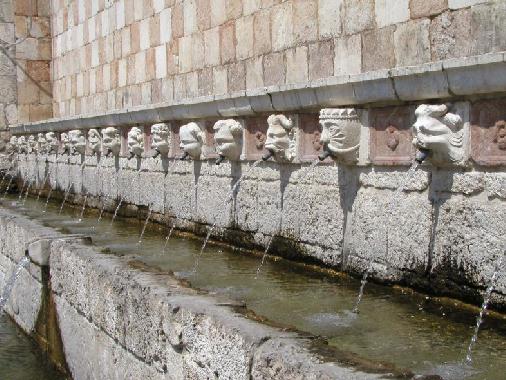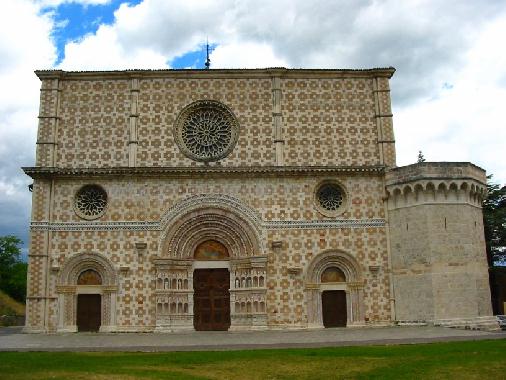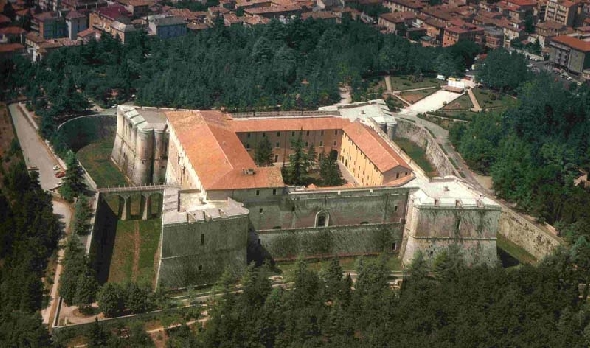|
|
1) Breve
Storia della città di L'Aquila.
2) A brief history of
L'Aquila (english version)
3) Information,transportation
to L'Aquila.
4) Image L'Aquila and
Links
|
Breve Storia della città
di L'Aquila. |
|
|
|
L’anno di
fondazione della città dell’Aquila è da ritenersi intorno il 1245 sotto il
governo dell’Imperatore Federico II°. Nel 1253 acquisterà prestigio e
grande aspansione sociale ed economica nel regno di Corrado IV°. La
tradizione vuole che alle origini della sua nascita , vi sia l’unione dei
99 castelli sparsi sul territorio circostante che contribuirono alla
costruzione di 99 piazze, 99 chiese, 99 fontane, ed a testimonianza
dell’evento lo splendido complesso della fontana delle 99 cannelle
(provate a contarle non avreta mai lo stesso risultato….).L’Aquila
raggiungerà una autonomia governativa ed economica (coniava moneta ) con
una crescente importanza politica nel periodo di Alessandro IV°. Nella
storia della città furono numerosissimi gli eventi che ne caratterizzarono
l’evoluzione, tra gli altri: nel 1259 la distruzione da parte di Manfredo, la ricostruzione alcuni anni
dopo, da parte di Carlo I°; nel 1272 la città è costituita dai quattro
Quarti (rioni) , il Quarto di S. Giusta, il Quarto di S. Flaviano, il
Quarto di S. Pietro, il Quarto di S.ta Maria di Paganica. Data
importantissima per la città è il 1249, anno dell’ incoronazione nella
Basilica di S.ta Maria di Collemaggio di papa Celestino V°, il santo
eremita la cui rinuncia al trono e la sua morte sono ancora oggi fonte di
discussione e misteri. ( A Celestino V° nel suo breve periodo di
pontificato si deve la promulgazione della "Bolla del Perdono" con
l’apertura della porta Santa nella Basilica di Collemaggio, celebrata oggi
alla fine del mese di Agosto, è la piu’ grande e sentita festa cittadina
sia religiosa che civile.) Negli annali di L’Aquila lotte e battaglie si
susseguono da Fortebraccio Conte di Montone, ai tremendi conflitti tra
francesi e spagnoli, nel 1532 Don Pedro di Toledo erige la possente
struttura militare del Forte Spagnolo (il Castello) altro simbolo della
città. Nel 1703 la città fu semidistrutta da un disastroso terremoto, ma
con forza e sacrifici fu ricostruita…… nel 1860 L’Aquila diventa ed è
tuttora sede del capoluogo della regione
Abruzzo. |
|
|
|
|
|
|
|
|
|
|
| |
|
| |
|
| |
A brief history of
L'Aquila
The foundations of the city
were planned by Emperor Frederick II° of Hohenstauffen in 1245. However,
the city had its greatest period of expansion under Conrad IV° and was
almost completed in 1253, just one year before his death. According to
tradition, the people who excuted Frederick’s plans were the inhabitants
of the 99 castles supposedly situaded in the Aquilan basin. The city had
an autonomous organization with a governor and a council and it acquired
such political and military importance that Pope Alexander IV° transferred
the ancient bishopric from Forcona to L’Aquila, building the church of S.
Massimo and S. George. In that period, the struggle between the Papacy and
the new Hohenstaufen king, Manfred, was already in progress and the city
paid dearly for having sided with the Church: in fact, after having
re-conquered the southern portion of his Kingdom, in 1259 Manfred besieged
and destroyed L’Aquila, which was then abandoned for 7 years until 1266.
This was the year in which Charles I° of Anjou, having taken possession,
of the kingdom of Sicily, called for the reconstruction of the town; in
1272, due to the efforts of Captain Lucchesino, work on the city walls was
commencedand the city was divided into 4 quarters. In this period the
Basilica of S. Maria di Collemaggio was built and Popo Peter of Morrone
was coronated there in 1294, taking de name of Celestine V°, in the
presence of Charles II° of Anjou. When the House of Aragon tried to sieze
the throne of Naples from the House of Anjou, the City loyal to Joan II°
of Anjou, was once again besieged, a situation which lasted for 13 months.
The siege was the work of Andrea Braccio Fortebraccio, Count of Montone,
under the orders of Alfonso of Aragon. The City resisted and when the
Aragons were finally defeated, Joan II° to thank L’Aquila for its loyalty,
conceded a series of priviliges destined to augment the town’s economic
and social development. Very quickly, L’Aquila became the second most
important city in the kingdom of Naples and prospered by commercial and
cultural excanges with the most influential cities in Italy and abroad. In
the 15° century L’Aquila was permitted to mint coins, the University was
established and printing house was opened in 1482 by A. for Rothwill, a
pupil of Gutemberg. The City’s spirit of independence wass finlly crushed
during successive struggles between the French and the Spanish for the
throne of Naples. The Spanish Charles V° ordered Philip of Orange to
besiege and destroy L’Aquila to punish her for having favoured Francis
II°; thus, in 1532, the Castle was erected by Don Pedro of Toledo " ad
reprimendam audaciam Aquilanorum". In 1647 the City rebelled agaist the
Spaniards and consequently was punished with strict economic and social
sanctions. In 1703 a disastrous earthquake shattered the entire city.
L’Aquila actively participated in the revolutionary movements for United
Italy and in 1860 became the Capital of the Region.
Transportation to
L'Aquila
L'Aquila is
located 100Km east of Rome in the Appenine Mountain , just below the Gran
Sasso peak (2914m). The nearest airport is Rome-Fiumicino. By public
transportation from there you may take the train up to the Tiburtina
Station (40 min) where you may board the bus to L'Aquila (90 min,
ticket 9 Euro). The company running the bus is ARPA and you should
buy your ticket before boarding the bus at the agency ARPA
located in front of the exit of Tiburtina Station. (New Bus
Station)

Le foto a seguirere sono tratte
da Internet, se talune fossere tutelate da diritti d'autore siete
pregati di inviarci una email csu_laquila@hotmail.com e saranno prontamente rimosse da questa
pagina, grazie!

|
|
|
|
The fountain of the 99 spouts
This is one of the oldest monuments and almost a symbol of
the city. Its originality is observed not only in its trapezoid shape and
in the stone masques, but also in the fact that the source of the water is
unknown. It was built in 1272 by Tancredi of Pentina, having been
commissioned by Captain Lucchesino, the Tuscan Governor

Basilica of Saint Mary in
Collemaggio
An important example of Romanesque-Gothic
architecture, it was commenced in 1287 under Peter of Morrone, the future
Celestino V, who wished to be coronated Pope there in 1294 (his remains
are kept in the mausoleum to the right of the main
altar).

P. Fonticulano (autore), G. Lauro (incisore), Città
dell'Aquila, (1600)
- (cm x cm) 38 x 51. Incisione. L'Aquila,
Biblioteca Provinciale.

|
|
|
The Spanish
Castle
This
magnificent fortress was built during the Spanish domination (16th
century) at the request
the Emperor Charles V. Used in past as a military arsenal and
also as a prison, it now cointains
of National Museum of Abruzzi. In one of the bastions,
there is a rare example of a one
the year old elephans meridionalis found near the city in
1954
Links
Università degli Studi
di L'Aquila
http://www.univaq.it
Comune di
L'Aquila
http://www.laquila.com
Parco nazionale
Gran Sasso e monti della Laga
http://www.parks.it/parco.nazionale.gran.sasso/index.html
Parco Naturale
Regionale Sirente-Velino
http://www.parks.it/parco.sirente.velino/index.html
Regione Abruzzo
per il Giubileo
http://www.regione.abruzzo.it/giubileo/itinerari/aquila/
|
You are here: Home-E N T E R C.S.U.-BIOGRAFIA-L'Aquila ( Storia )
Next Topic: Libri-documenti
Built with Enersoft SiteGenWiz Freeware Ed. |
